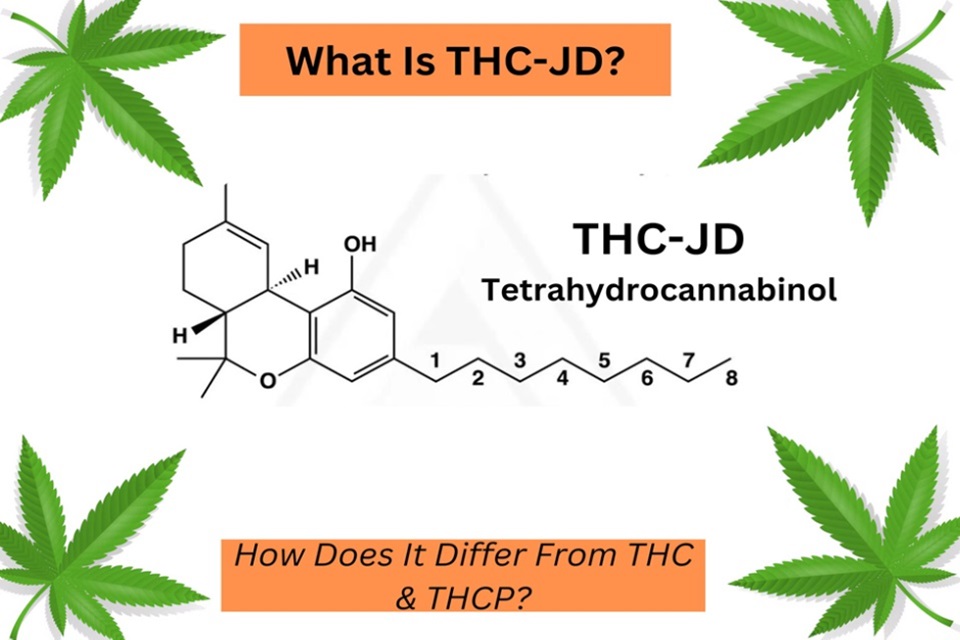THC-JD: What Is THC-JD, Its Benefits, & How Does It Differ From THC & THCP
The cannabis plant is known for its complex chemistry, boasting a variety of cannabinoids that contribute to its diverse effects. Among these, THC (tetrahydrocannabinol) is the most well-known for its psychoactive properties. However, the discovery of new cannabinoids like THC-JD has intrigued researchers and consumers alike. In this article, we will delve into what THC-JD is, its molecular structure, benefits, differences from other cannabinoids, and its legal status.
Introduction: What Is THC-JD?
THC-JD is a new type of cannabinoid that has recently been discovered. It is getting attention because it may have unique effects and benefits. While it is similar to THC and THCP, THC-JD has its own distinct properties. This cannabinoid is part of the growing field of cannabis research, and it could offer new options for both medical and recreational use.
Molecule Structure
The molecular structure of THC-JD is similar to other cannabinoids, comprising a combination of carbon, hydrogen, and oxygen atoms arranged in a specific pattern. However, what makes THC-JD unique is the addition of two extra carbon atoms in its alkyl side chain. This structural variation can influence its interaction with the body’s endocannabinoid system, potentially altering its effects and potency compared to other cannabinoids like THC and THCP.
How Is It Made In The Lab?
THC-JD can be synthesized in a laboratory setting through a series of chemical reactions. The process often involves starting with a base cannabinoid, such as CBD, and then using specific reagents and catalysts to alter its molecular structure. This method allows researchers to create THC-JD with precision, ensuring consistency and purity. Laboratory synthesis is essential for studying THC-JD’s properties and potential applications, as natural concentrations in cannabis plants are typically very low.
Study Of Differences
Difference Between THC-JD & THC
The primary difference between THC-JD and THC lies in their molecular structure. THC-JD has a longer alkyl side chain, which may enhance its ability to bind to cannabinoid receptors in the brain. This stronger binding affinity could result in more potent psychoactive effects compared to THC. Additionally, THC-JD might offer a different therapeutic profile, potentially benefiting conditions that do not respond well to THC.
Difference Between THC-JD & THCP
THC-JD and THCP both have extended alkyl side chains, but THCP has an even longer chain than THC-JD. This structural difference might make THCP significantly more potent than THC and THC-JD. While both cannabinoids could offer enhanced effects and benefits, their distinct molecular structures mean they may interact with the body differently, leading to varied therapeutic and psychoactive outcomes.
Potential Benefits & Side Effects Of THC-JD
| Potential Benefits | Potential Side Effects |
| Pain relief | Dry mouth |
| Anti-inflammatory effects | Dizziness |
| Anxiety reduction | Paranoia |
| Improved sleep | Appetite changes |
| Neuroprotective properties | Short-term memory issues |
Can A Drug Test Detect THC-JD?
Standard drug tests typically screen for THC metabolites, not THC-JD specifically. However, because THC-JD is chemically similar to THC, it is possible that using THC-JD could result in a positive drug test for THC. Advanced testing methods could potentially differentiate between THC and THC-JD, but these are not commonly used in routine drug screening.
Is THC-JD Legal?
The legality of THC-JD is a complex issue, varying by region and jurisdiction. In many places, cannabinoids are regulated based on their similarity to THC and their psychoactive effects. Since THC-JD is a relatively new discovery, it might not be explicitly mentioned in existing laws. However, if it produces similar psychoactive effects to THC, it could be subject to the same legal restrictions. It is essential to check local laws and regulations regarding cannabinoids to determine the legality of THC-JD in your area.
In Summary
THC-JD is an emerging cannabinoid that shares similarities with THC and THCP but offers unique properties due to its molecular structure. It holds the potential for enhanced therapeutic benefits and different psychoactive effects. Understanding the differences between these cannabinoids can help consumers and researchers make informed decisions about their use. As with any cannabinoid, it is crucial to consider legal implications and potential side effects.
FAQs
- What makes THC-JD different from regular THC?
THC-JD has a longer alkyl side chain, which may increase its binding affinity to cannabinoid receptors, potentially leading to stronger effects.
- Can THC-JD be found naturally in cannabis plants?
THC-JD is found in very low concentrations naturally, making laboratory synthesis essential for research and application.
- How does THC-JD compare to THCP in terms of potency?
While both have extended alkyl chains, THCP has a longer chain than THC-JD, which might make it more potent.
- Are there specific medical conditions that THC-JD could potentially treat better than THC?
Research is ongoing, but THC-JD may offer unique benefits for conditions that do not respond as well to THC due to its different molecular interactions.





